It was in the autumn of 2019, when I walked past wild olive trees at the foot of Mount Olympus and picked a few of the firm, green fruits here and there. Ferment olives, the idea was there at once! Unfortunately, there weren't enough wild olive trees to harvest a respectable amount of olives for this endeavor, so a few days later I went to the Κεντρική Δημοτική Αγορά Αθήνας, the central market in Athens, filled up the kilo and took it all back to northern Germany as a fresh, fermentable souvenir.
In their raw state, olives are horribly bitter and toxic due to the presence of the compound oleuropein. Before olives can be eaten, they are always cured to reduce oleuropein.
Sandor Ellix Katz, The Art of Fermentation
Curing, of course fermenting, but how? I had to figure out the way to do it. The most important thing in processing fresh olives, leaching the oleuropein compound, can be achieved in several ways. The most common methods to debitter and ripen olives are with brine, dry salt, water or lye.
Fermenting olives
In industrial production, the olives are soaked in sodium hydroxide solution. Of course, you can do this at home, it's fast and efficient - but that's not what I'm about, I'd rather ferment the fruit. Olives, in fact, contain many valuable nutrients that are preserved by the natural ripening process of fermentation, while at the same time debittering and preserving the fruit.
Harvest olives
If you don't live in a country where olives grow and you can either harvest them yourself or just buy them at the market, you can ask your greengrocer to bring you a box from the wholesale market. My local vegetable dealer is happy to do this for me, so that I can ferment olives myself every year. A box of 4-5 kg is just about enough for our annual consumption.

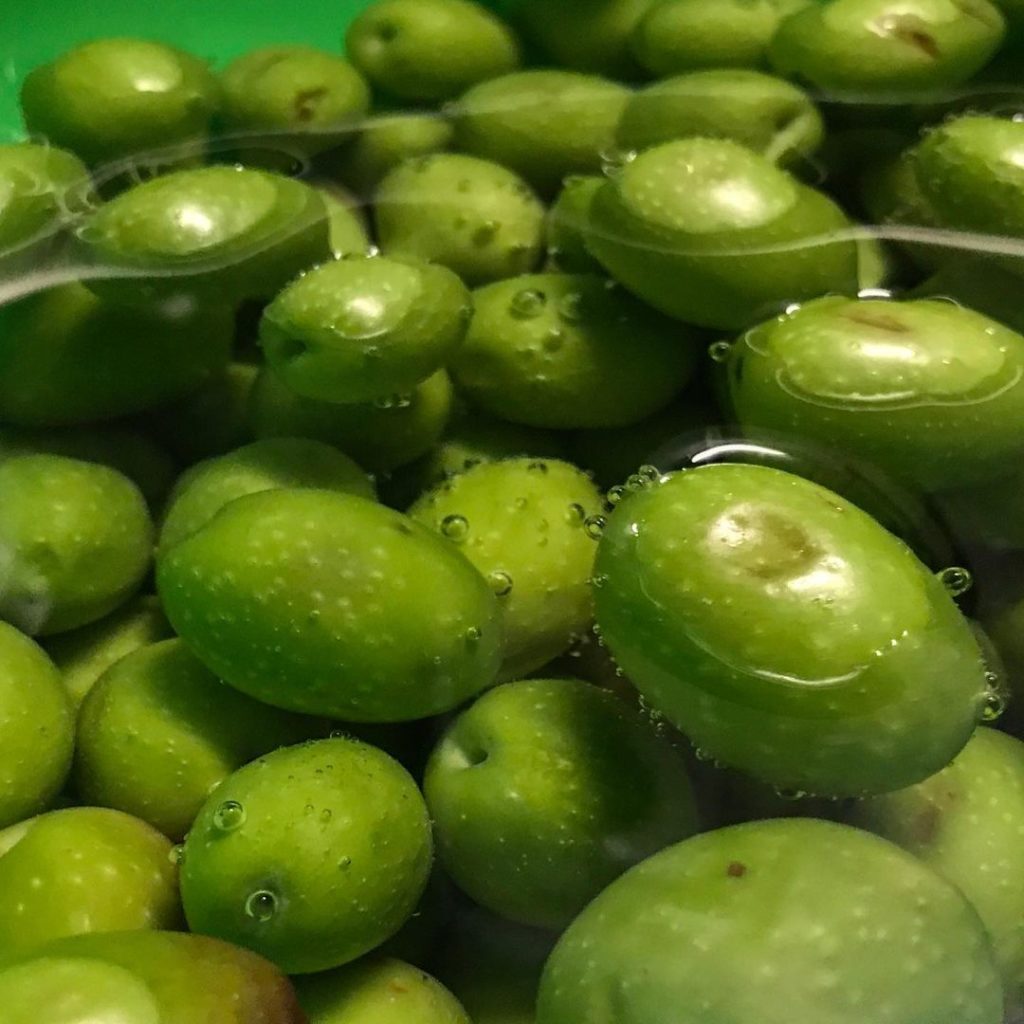
Green or black olives?
The color of the fruit is a sign of its ripeness. If you leave green olives on the tree long enough, they turn black and softer in texture. For fermenting, I prefer the crisp, green olives that are just beginning to ripen. You can tell because the olive is starting to turn slightly yellowish. Green olives are more bitter and very healthy due to their high polyphenol content.
INGREDIENTS
- fresh green olives
- rock salt
- water
- large bowls
- bail glass / glasses
PREPARATION
Examine olives thoroughly and discard fruit with dark spots or black dots. Dark spots become mushy in the course of fermentation, and the black dot indicates an infestation of olive fly. If some olives are already blackened in the sun, it is not a problem, they are a delicious addition.
Water olives
Put olives in one or more large bowls and let them float in plenty of water for 10-14 days. Change the water daily. The fruits will lose their strong green color, become more and more yellowish and at the same time lose their bitterness.
Move the olives in the water 1-2 times per day and check for damaged areas. Olives affected by fly disease, which were previously imperceptible, may now appear. To check, take a knife and cut into the questionable olive. If you see small blackish cavities in the flesh of the olive, please throw it away. Although it hurts one' s heart, all damaged fruit must be removed immediately.
After 10 days you can taste the first olive. The goal is a pleasant bitterness, which is achieved after 10-14 days. The olives should not be allowed to soak longer before further processing. During lactic fermentation, the olives lose even more of their bitterness.
Put olives in brine
Cover the olives in the fermentation jars with water. Remove the water again, add 3% salt and let it dissolve. This is best done by stirring vigorously. Add the brine back into the jar with the olives. Note on the vessel how many grams of salt were used! This is especially important if you have several vessels of different sizes.
Leave the olives to ferment in the brine for two weeks. After 14 days, open the jars, take out some brine and dissolve it with the same amount of salt that was used in the first brine. That's why you noted the grams on the jars. Fill the now about 6% brine up again and close the jars.
HINT: If during the first fermentation kahm yeast formed, you can remove it immediately after opening the jars. This is best done with an absorbent cloth.


Hopefully the olives smell fantastic, even though they can still be quite bitter. Now the jars are placed in a dark and cool place and best just forgotten for a few months. Olives are slow food and another test of patience for fermentistas.
Ferment olives for at least 8 weeks
The lactofermentation gives the olives their unique flavor and the lactic acid bacteria bring a positive effect on the gastrointestinal microflora. The polyphenols contribute to cell health as antioxidants and have additional anti-inflammatory effects. Lactic acid fermentation is really fantastic!
If you like the taste of the olives after 8, 12 or more weeks, you can portion them into smaller screw-top jars and store them cold. Or eat them right away. Or give them as a gift. Fermented olives are really great.
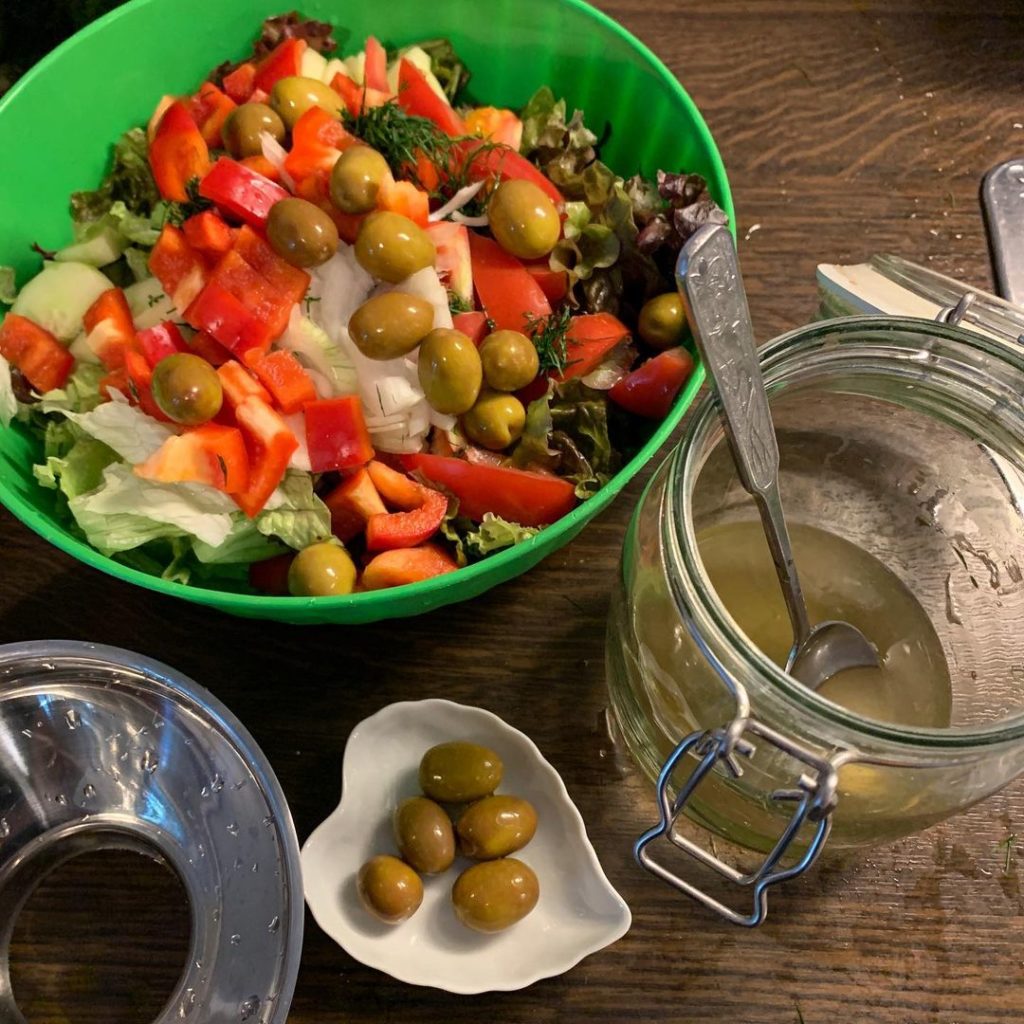
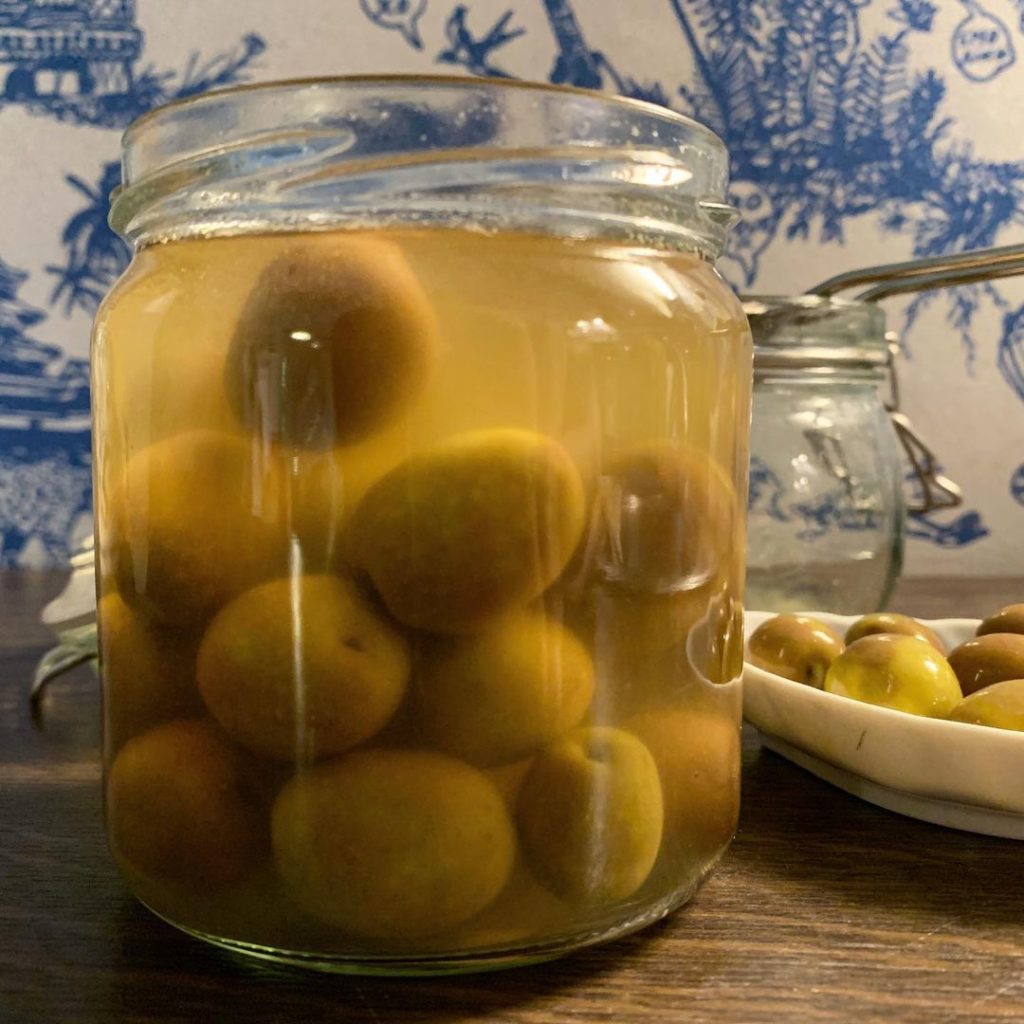

If you enjoy green fermented olives, I recommend you also get inspired by my other mediterranean ferments.

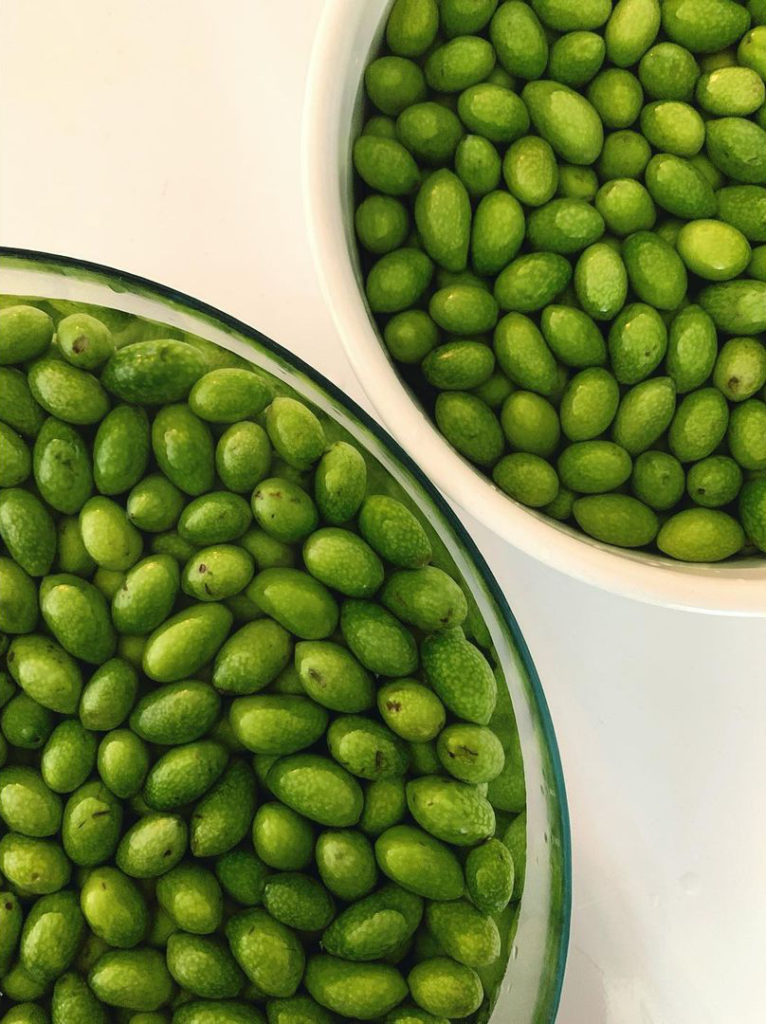
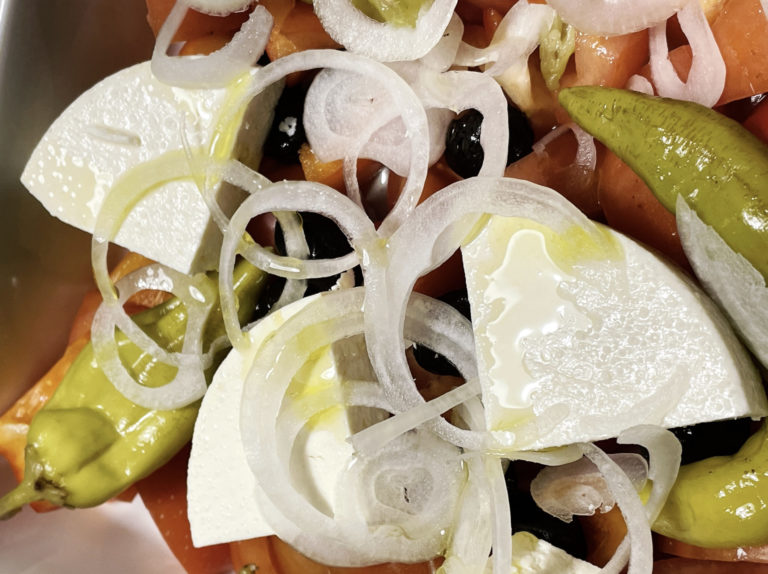
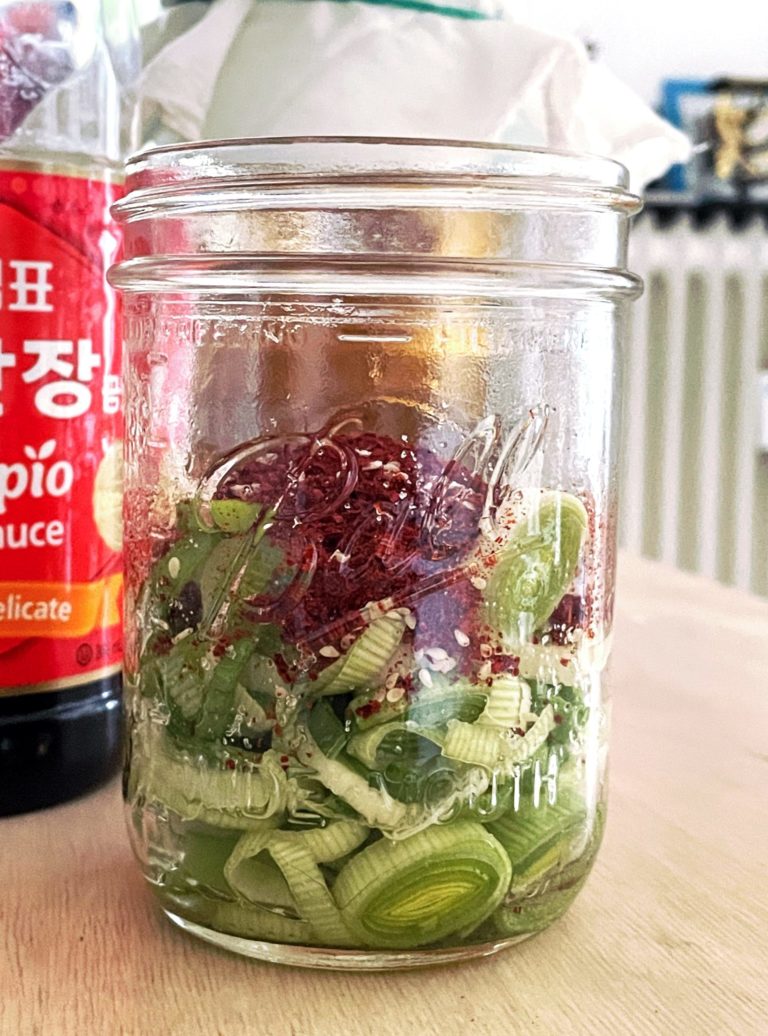

Grüß Göttin, so weit mir bekannt ist, ist Oleuropein sehr gesund. https://www.internetchemie.info/chemie-lexikon/stoffe/o/oleuropein.php
https://de.wikipedia.org/wiki/Olivenbl%C3%A4ttertee
Moin Horst,
kiekste mal, dass wusste der gute Sandor nicht, und ich bis eben auch nicht. Danke für’s Aufschlauen! Das Rezept wird davon zum Glück ja nicht beeinträchtigt.
Best regards,
Katsu
Hallo, ich hab da Fragen zu den Oliven.
Ich habe frische Oliven beim türkischen Markt meines Vertrauens gesehen.
Fragte dort: o.k. frische Oliven….das ist klar, aber wie verarbeite ich sie?
Man erklärte mir: Mehrmals mit dem Messerc einritzen (bis zum Kern). 2 Wochen mindestens in ein Glas und mit Frischwasser füllen. Jeden Tag das Wasser erneuern.
Nach 14 Tagen etwas in einem Gemisch aus Olivenöl, Zitronensaft und evtl. Rosmarin einlegen.
Och fragte noch mal nach……ohne Salz?
Kam….ja….so machen es die türkischen Olivenbauern.
Damit ich durch die Zitronen keine Gärung auslöse, dachte ich mir ich aromatisiere das Öl in meinem Rommelsbacher (hat Kröuterfunktion) mit Zitronenzesten, Rosmarin, Korisnder und evtl. Knofi.
Wenn ich jetzt noch Salz von mur aus zufügen würde…….geht es dann schief?
Oder soll ich sie nach dem Wässern wie es hier beschrieben wird erst fermentieren und danach in dem aromatisiertem Öl einlegen.
Oder nach ich dann alles kaputt.
Wenn ich dem aromatisierten Öl Salz zufüge, löse ich dann ebenfalls eine Fernebtation aus, die schief geht.
Sie sehen…..ich bin jetzt echt ratlos.
Das Glas, was ich jetzt am Wässern bin….ist jetzt fällig zur Weiterverarbeitung. Und morgen könnte ich nich mal 5 kg bekommen, wenn der Händler am Großmarkt noch welche bekommt. Die Erntezeit ist fast vorbei.
P.S. ich habe die leise Vermutung, dass die Variante vom Supermarkt nur zum schnellen Verzehr bestimmt ist.
Noch was…..ich würde vor dem Aromatiieren des Öles die Zitronenzesten erst dörren. Dann ist vielleicht eine Görung gebannt.
Was ich mir auch vorstellen kann ist die Beschreibung hier…..Wässern…..Fermentieren (dann ist der Salzgehalt vorhanden. Und da dann im Anschluss die Oliven in mein aromatisiertes Öl einlegen. Das Öl dann ohne Salz.
Wäre das in Ordnung.
Sie sehen…..ich brauche wirklich Hilfe…..und das schnell.
Ich bedanke mich im voraus ganz herzlich.
LG Petra
Liebe Petra,
wie Du an meinem Rezept siehst, mache ich Oliven ohne Öl. Generell ist es wichtig, dass das Gemüse einen pH-Wert von unter 4,5 hat, bevor es mit Öl versetzt wird. Das Botulismusrisiko ist sonst zu hoch. Also, bitte wässern, fermentieren, und erst das fertige Ferment mit Öl versetzen.
Gutes Gelingen!
Katsu
Hallo Katsu,
Genau so werde ich es machen.
1. Weil es mir auch um das Milchsäureergebnis geht.
2. Weil ich schon bei anderen Fermenten von der langen Haltbarkeit überzeugt wurde.
Denn darauf kommt es nur an. Habe mit der Fermentation meiner Ernährungsumstellung nach TCM eine größere Variantenauswahl gegeben.
Mein Stoffwechsel und Imunsystem, beides funktioniert wieder.
Hatte nie bessere Werte.
Hab nun doch noch eine Frage. Kann ich beim Fermentieren schon Kräuter (Rosmarin, Oregano, Kardamonkapseln, fruschen Knoblauch und frische Zitrone (Abrieb) mit zugeben ?
Oder das Öl, was ich nun erst zu den Oliven gebe wenn alles auf den Teller kommt mit frisch gebackeren Seeken, stärker aromatisieren?
Wäre ich, wenn ich überlege, nicht am Geschmack gebunden.
Denn…..ich hab gestern noch mal 10 kg grüne Oliven bekommen.
Heute Arbeit vorm TV-Krimi. 🤭🤭🤭.
Und das Olivenöl kann auch besser eingeteilt werden.
Das kommt von einer Bekannten ihrem Onkel direkt von seinen Bäumen in der Türkei.
Also kein Industriemist.
Ich hab mich vollkommen von Konservierungsstoffen der Industrie und Geschmack aus dem Labor verabschiedet. Mache alles selbst. Kefir, Joghurt, Brot, Belag fürs Brot, Räucher auch auf dem Programm, Gewürze und so Vieles mehr.
Übrigens bin ich Imkerin und stolze Wächterin von 8 Beuten. Und ja ich rede mit ihnen. Und nur 16 Stiche in 2022 bei hochgerechnet 400 000 fleißige Mädels haben mir zudem noch Arthroseschmerzen und andere Gelenkschmerzen genommen.
Bitte antworte mir zeitnah wegen Gewürzzugabe beim Fermentieren, da ich spätestens morgen meine Proberunde vom Wässern befreien muss.
Ich danke Dir recht herzlich
Petra
Sich aber wie jetzt zusätzlich austauschen macht zudem noch Spaß.
Liebe Katsu,
bin zu dem gleichen logisch gekommen.
Werde das Öl extra halten und erst mit auf den Teller geben wenn die Oliven verspeist werden.
Eine Frage trotzdem. Kann ich bei Gang 2 (Fermentieren) Kräuter. Knofi und Zitrone beigeben ohne Schaden anzurichten, oder es nur beim Salz belassen?
Morgen müsste ich das Probeglas vom Wässern befreien und fermentieren.
Putze heut schon ewig die neue Lieferung. 🙈🙈. 10 kg.
Da muss ich mehr putzen. Aber ich werde ich schon schaffen. Müßte 1 Jahr köstlicher Genuss werden.
Eine schnelld Antwort wöre schön. Wegen 2. Stufe morgen.
Vielen Dank im Voraus
Petra
Liebe Petra,
ja genau, vertrau Deiner Intuition. Mit dem Öl bis zum Verzehr zu warten, klingt gut.
Gewürze und Kräuter kannst Du auf jeden Fall mit ins Glas geben. Wichtig ist, dass alles von der Lake bedeckt bleibt, also am besten tust Du sie zuunterst rein. Bei der Zitrone wäre ich sparsam, sie bringt eine bittere Note mit. Da die Oliven sowieso bitter sind, könnte das leicht zu viel werden. Vielleicht arbeitest Du nur mit dem Saft, das kann ich mir gut vorstellen.
Gutes Gelingen, ich freue mich auf Deinen Bericht, wenn die Oliven fertig fermentiert sind!
Best regards,
Katsu
Hallo Katsu! Inspirierender Bericht über die Olive 🙂 Danke dafür! Wollte ich direkt mal selbst ausprobieren. Deswegen an dieser Stelle eine Frage: Habe gestern meine Oliven zum Wässern in eine Flasche gegeben. Heute wollte ich das Wasser wechseln und beim Öffnen des Schraubverschlusses hat es deutlich hörbar Druck abgelassen. zisch, plopp… Ich dachte „Gären die Oliven etwa schon nach einem Tag? Ist das normal? Oder sind die drüber?“ Vielleicht gibt es dazu ja auch Erfahrungen… Lieben Gruß Vanessa
Hej Vanessa,
ja, das kann durchaus passieren. Schau mal dieses Video an https://youtu.be/YOLrfRGMQfA.
Also, klingt alles gut!
Gutes Gelingen weiterhin,
Katsu
Dann habe ich ja noch Hoffnung. Danke für den Clip. Ein paar Perlen konnte ich auch schon beobachten 🙂
Hallo Katsu,
eine frage- was für Ph Wert sollen die Oliven am Ende haben, damit sie sicher sind (Botulismus)? Ist es bei allem fermentiertem so, dass der Ph Wert mindestens die 4,5 erreichen soll?
Übrigens finde ich deine Webseite super inspirierend!
Danke & liebe Grüße
Katka
Hej Katka,
japp, Laktofermente sollen generell möglichst schnell sauer werden und idealerweise innerhalb einiger Tage einen pH-Wert von 4,5 oder weniger erreichen. Das gilt auch für Oliven.
Gutes Gelingen!
Katsu